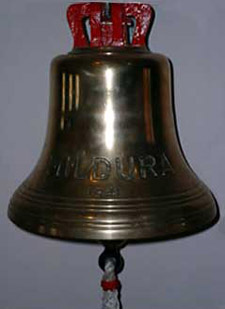 Time and Watches on Ships
Time and Watches on Ships
On board a ship the day was divided into Seven Watches, and the crew into two divisions - the Starboard (on the steersman's right) and the Port (on the steersman's left). These divisions break up the watching and working of the ship into convenient portions, and enable to crew to watch and work at alternate times. The Time is kept by means of bells , which are struck at certain intervals.
| Afternoon | Watch from Noon to 4 pm |
| First Dog | Watch from 4 to 6 pm |
| Second Dog | Watch from 6 to 8 pm |
| First | Watch from 8 to 12 pm |
| Middle | Watch from 12 to 4 am |
| Morning | Watch from 4 to 8 am |
| Forenoon | Watch from 8 to Noon |
The bells were struck for every half-hour of each watch, with a maximum of eight bells. For instance, during the Middle Watch you would hear the the following:
00:30 1 bell
01:00 2 bells
01:30 2 bells, pause, 1 bell
02:00 2 bells, pause, 2 bells
02:30 2 bells, pause, 2 bells, pause, 1 bell
03:00 2 bells, pause, 2 bells, pause, 2 bells
03:30 2 bells, pause, 2 bells, pause, 2 bells, pause, 1 bell
04:00 2 bells, pause, 2 bells, pause, 2 bells, pause, 2 bells
At eight bells your watch was over! All other 4 hour watches followed this same procedure except the Dog Watches.
At the end of the First Dog Watch, only four bells were struck, and the Second Dog Watch bells were struck like this: 6:30 PM, one bell; 7 PM two bells; 7:30 PM, three bells; and at 8 PM, eight bells.
The ship's boy used a half hour sand glass to keep the time, when the sand had run out, his task was to turn the glass over to reset it, and ring the appropriate number of bells.
Since 1915, all U.S. Merchant vessels over 100 gross tons have, by law, divided the crew into three watches, working four hours on and eight hours off, and turning the dog watches into one evening watch.
